Lupine Betty model 2011
Tested: From 17-29 Nov. 2010
This lamp was on loan from Charles Tsai / Intelligent design cycles, thanks!
Specifications:
Lupine Betty model 2011, it comes complete with a storage bag to keep the lamp and accessories in:
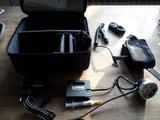
Mass: Lamp head 127g with ca. 35 cm cable, battery 334 g.
Size: Lamp head ∅ 54 mm, length 43 mm, and 53 mm with the bit of the mount that sticks out.
LEDs: 7 x Cree XP-G R5 cool white
Lens: 16° (fairly narrow as you will see from the beamshots)
Price: ca. € 770,-
Pictures:
Mounted on a bicycle it looks like this:

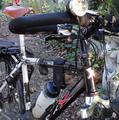
The lamp head is mounted on the handlebar with a thick rubber band. The battery is fastened with velcro so you can hang it on the top tube of the bike. It has a precaution that takes care of a 'what if' situation that I wondered about with the Magicshine: What if for some reason the velcro doesn't hold (e.g. if you haven't pushed the 2 sides firmly enough onto each other)? With the Magicshine the battery would just fall down hanging from the cable, the connector will then probably get loose, and the battery hits the ground likely damaging it. Perhaps not a likely problem, but it can happen. The Lupine people have thought about this obviously, as there's an additional clasp of the type used on bags...
|
First impression of the lamp, charger etc.: Everything here exudes quality, it's almost incomparable to a Magicshine lamp. The charger, 'Charger one', for example has an aluminium casing with blue backlit LCD (text in white) showing what's being done. The cables of the battery are very flexible, and noted on them is that they are ok up to -40 ° C. The box contains manuals in colour clearly showing how the lamp and charger work. Then there's a little syringe with lubricant to put on the connectors for rides in the wet, to keep them from corroding. On the syringe is printed "Dutch grease". Is that because of the almost always poor weather here? Apt I suppose, although calling it English grease would perhaps be even better ;-) For the price, which is about 8 times that of the Magicshine MJ-808 (but with a claimed light output of ca. 1850 lumen which seems real considering it has 7x XP-G LEDs, so a little more than 3 x what the Magicshine MJ-808 produces), expecting this kind of quality is perhaps logical. I have to say, presentation and quality leave very little to be desired. Well, perhaps a quickstart leaflet if you don't want to walk through the manuals but immediately want to try it out?
Experiences:
Note that I review this lamp not for how well it's suited for its actual purpose, i.e. nighttime mountain biking (although I do have a comment about the optimal beam shape for MTB use at the end of this review) but to see what one experiences with this much light, and to see how well it lights up a regular road compared to a Philips LBL.
The lamp is mounted on the handlebar with the rubber band method, which is probably a good method for mounting lamps you want to take off again quickly. The lamp will rotate around the handlebar a bit pressing the button to switch it on or switch brightness levels so you need to keep the whole lamphead in your hand pressing a button to prevent that. I tried this both with a dry handle bar and a wet one, and interestingly I didn't experience a difference...
Oncoming test
It seemed strange at first, but when riding towards the Betty (at full power), which I placed on a pole and aiming it fairly far so I would get a lot of light directly into my eyes, I never got blinded as badly as with the Magicshine! (despite the large difference of ca. 1850 lumen vs. 550 lumen)
The amount of light that gets in your face is enormous, and definitely not pleasant, but I could still see the sides of the road or bushes beside it. Upon reflection I think the reason for this is that the Magicshine has a not all that strong general illumination coupled with a fairly strong hotspot (that was shining in my face when I did the test, as I aimed the Magicshine fairly far). This means the road and sides of the road with the Magicshine are not that well illuminated, at least not enough so that you can see them from the reflected light off of the light coming from that beam despite the direct light from the light beam getting into your eyes. Note that in both cases my own headlamp, Cyo in the test with the Betty, and Edelux in the test of the Magicshine, were useless to see anything. In the case of the Magicshine this meant I saw nothing, in the case of the Betty could however see enough of the road/surroundings. Why is this? Well, with the Betty it's different as it has a much more homogeneous beam that puts out so much light to the sides of the road and onto the road itself, on all points of the road, that I could still see the road or bushes on the side of the road, just from the light of the Betty's beam that gets scattered from those objects.
Beamshots on road 1: Camera height: ca. 1.65 m, camera aim: ca. horizontal.
Lupine Betty oncoming at 30 m
 |
Philips LBL oncoming at 30 m
 |
Fog test
Betty on full power, in picture 2 there's someone at 30 m distance from the lamp. The 2 oncoming shots are from a camera height of 1.15 m (using the old tripod), and 1.65 m (from my hand, so a bit shaky):
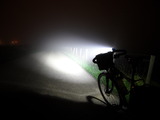
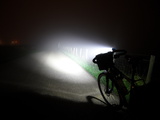
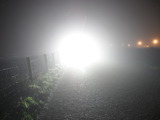
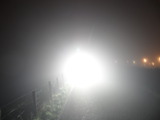
Now a test that's more meant for the LED experiments page, and I may move this section there later, namely seeing at which distance the light from the lamp gives a 'wall of light' phenomenon. It seems from these tests that there's very little difference with this 1850 lumen lamp and a much less powerful torch of say 100 lumen. Here's a Betty at full power at about 5cm, 30 cm and 60 cm from the camera lens:
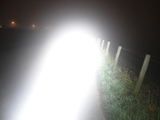
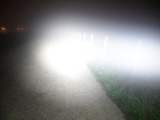
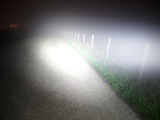
These actually look worse than I experienced when using the lamp because the light beam is aimed fairly close to the ground, so a distance of about 60 cm is enough to be able to see properly, so a bar mounted lamp you could just be ok, but I think with a helmet mounted lamp you could have trouble. I also tried the difference between the Betty running at full power and at 10% power, and amazingly, with 10% I could see as good, perhaps even slightly better. So with fog, more light isn't necessarily helping...
Beamshots:
For background information on making beamshots see: Camera settings, lamp settings and roads used to make the beamshots.
I've made various beamshots in different places comparing it to the Philips LBL, as that's really my main interest, to see how much better/worse it is than such a lamp and how much you gain from extra light, etc. First some pictures of just the Betty on road 2 (note: to prevent the lamp dimming due to heat, pictures are taken a few seconds after switching the lamp on, temperature was about 4°C):
What is noticeable is that there's very little change in illumination at long distance pointing the lamp close or farther away on the ground. This is the same effect I saw with the Magicshine MJ-808 and the Ktronik triple XP-G. Also, when aiming the lamp close, it looks very impressive in the beamshot, very bright, but you should know the eye adapts to the light, so actually the near-field is now too bright so you don't see as well further ahead. All in all my side by side comparisons really confirm what I've said on my lighting pages, namely that a lamp with a good beam with cutoff, i.e. with fairly even illumination of the road surface and not much above the horizon, delivers much more usable light for the same power.
Beamshots on road 1: Camera height: ca. 1.65 m, camera aim: ca. 50 m, position: ca. 2 metre behind the lamp/bike.
Philips LBL, high
 |
Lupine Betty, full power
 |
Philips LBL + Lupine Betty
 |
The following pictures have been taken on the same road, but in another position quite a long distance away to give give some idea of how the lamps light up not just the road, but what's beside it, which is more what you need for mountain biking (the real purpose of course, of this lamp). Look closely for the retroreflective marker at 75 m and note that the throw of the Philips LBL is almost that of Betty (to see this, you need to keep in mind that with the Betty the close field is a bit overexposed unless pointed upwards, so the pictures make the difference look bigger than what you experience as the eye adjusts to the brightest light it sees): |
Philips LBL, high
 |
Lupine Betty, full power
 |
Philips LBL + Lupine Betty
 |
Road 3, 2010-11-28
It was freezing (ca. -4°C), fairly strong wind, moisture from the previous rainy days was frozen on the gras and some parts of the road surface.
Beamshots on road 3: Camera height: ca. 1.65 m, camera aim: 2nd marker at 50m, position: 0.40m behind the lamp. There are some small white sticks (not retro-reflecting) on the ground at 10 m and 15 m distance on the left and right hand side of the road.
Philips LED bike light |
1.05 m, low mode

|
1.05 m, high mode

|
Lupine Betty 2011 |
1.05 m, 10%

|
1.05 m, full power, aimed close

|
1.05 m, full power, aimed far

|
Oncoming test on road 3, 2010-11-28
Beamshots on road 3: Camera height: ca. 1.65 m, camera aim: 2nd marker at 50m, position: 0.40m behind the lamp. There are some small white sticks (not retro-reflecting) on the ground at 10 m and 15 m distance on the left and right hand side of the road.
Lupine Betty 2011 |
1.05 m, full power, aimed far

|
1.05 m, full power, aimed far, oncoming view at 30 m

|
1.05 m, full power, aimed close
(I made no picture of this, but it's similar to above,
the case where the Betty was aimed close)
|
1.05 m, full power, aimed close, oncoming view at 30 m

|
1.05 m, full power, aimed very close

|
1.05 m, full power, aimed very close, oncoming view at 30 m

|
In all cases the amount of light oncoming traffic gets in their face is huge although with the very closely aimed Betty it's not all that bad. However, only with the Betty aimed far will you get a lighting of the road that's better than a Philips LBL, and with the Betty aimed very close, which is the only setting I found acceptable for oncoming traffic, the Betty is simply rendered nearly useless and no better than a standard dynamo lamp because the near field (close to your front wheel) is illuminated far too brightly and your eyes will adjust to that.
Conclusion:
Huge amount of light, and I'm not rating it as a bike lamp for on-road riding, because that's obviously not what it's for. What is clear from my experiences (and this comes across less well in the pictures due to the fact that the eye adapts to the brightest light source, which is also the reason why strong oncoming lights result in not being able to see the road, such as happened in my tests with the Magicshine), is that the Betty (2011 version) at a claimed 1850 lumen, which it undoubtedly can produce with 7 x XPG-R5, i.e. 7 x more light than the Philips LED bike light, is only slightly better at lighting up the road than the Philips LBL. I would further say that from comparing the Betty with the Philips LBL, it is fairly clear that having a wide, even illumination of the road surface is very important, even more so when mountain biking so you can choose your trail. This also means a lamp for MTB use could be made a lot better if it didn't have a symmetric beam, but a beam such as the Philips LBL, but even wider and with more light added that goes above the horizon. If you take the light from the Betty, unless you're riding in a dense forest, the light going straight up is just going up into space, and that light could have been used better further on the road/trail, or to the sides.
I think the best use for the Betty is actually as a helmet lamp. Couple that with a very wide beam bar-mounted lamp and that should be all the light you need for nighttime mountain biking...
Last modified: Fri Dec 21 10:49:38 CET 2012





























